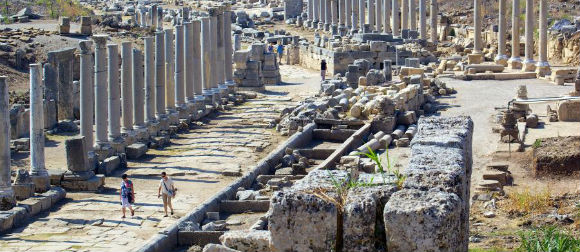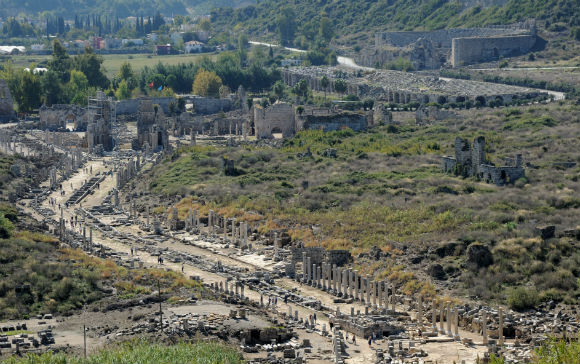The most impressive ruins of the Pamphylian coast are at Perge, at about 15 km east of Antalya. Perge was originally founded by the Hittites around 1500 BC. and was known as Parha. It was a successful trading centre near the Aksu (ancient Kestros or Cestrus) river when Alexander the Great arrived in 333 BC. He was welcomed in by the inhabitants and used Perge as base for his Anatolian campaigns. Alexander was followed by the Seleucids under whom the city prospered and Perge’s most celebrated inhabitant, the mathematician Apollonius from Perge lived and worked. Apollonius was a pupil of Archimedes and wrote a series of eight books on geometry. In 188 BC Perge became part of the Roman Empire during which the city flourished. Most of the surviving buildings date from this period.In 46 AD St. Paul started his journey in Perge (biblical Perga) and preached his first sermon here. Perge gradually declined during the Byzantine period, as the Aksu river silted, but remained inhabited until Selçuk times after which it became abandoned.
A visit to Perge starts by entering the archeological site through the Roman Gate, built during the reign of Septimius Severus (193-211 AD). Proceeding through the gate, to the right is the Agora or market place. This structure of 75 x 75 m dates back from the 2nd century AD. The center courtyard and shops were surrounded by a wide stoa, a covered walkway. The floor of the stoa and shops was made of colored mosaics. The agora was not only the centre of Perge’s trade, but was also a place for meetings as well as a forum for political, social, and philosophical discussions. The next building is the Hellenistic city gate that dates back to the 3rd century BC. This is certainly the most imposing building of the city and was cleverly designed to protect the city with its twin towers and its horseshoe-shaped courtyard at the back. It is thought that the towers had three floors and were crowned by a conical roof. In the year 121 AD, the horseshoe-shaped courtyard was rededesigned as a courtyard of honor. Behind the courtyard stood a triple arch. Around the arch there are about dozen inscriptions connected with Plancia Magna who lived in the 2nd century AD. She was the daughter of the governor, a priestess of Artemis Pergaia (Diana) and a benefactress to the city. Plancia Magna had the arch decorated with the statues of the emperors and their relatives.
After passing through the Hellenistic Gate and courtyard, one enters a broad, marble-paved double-colonnaded street measuring 300 meters in length that extends from the main gate to the acropolis. The street is 20 m wide and is divided in two by a 2 meter wide water channel running down the middle. At the end of the colonnaded street is the Nymphaeum, a triumphal fountain from where a stream flowed down into the water channel. The nymphaeum or nymphaion is an ornamental semicircular structure and dates from the reign of Emperor Hadrian (130-150 AD). A statue of a river god Kestros was located in the center of this huge fountain. Behind the nymphaeum is the acropolis with some remains of the Byzantine period. To the west of the nymphaeum are the remains of a palaestra dating from 50 AD and dedicated to the Emperor Cladius (41-54 AD).
Returning back to the entrance, there are the excavated Roman baths located southwest to the agora. Out of the site proper, is the horsehsoe-shaped stadium, the largest in Asia Minor, measuring 234 m by 34 m. The stadium had a seating capacity of 12,000 people supported by massive barrel-vaulted constructions. Just beyond the site entrance is also the theatre, which is of the Greco-Roman type and could seat 15,000 people. Unfortunately, it is for some time under reconstruction and unfortunately closed to visitors.
Perge,



Perge is very impressive little city located a few km from Antalya. It's very easy to get there by car ( but I am sure that also by buses) as it's just of the highway.
Impressive ruins where you can walk in the old street see the shops were in the Agora area and the big baths. They had 3…
Perge was an eye opener. So much history there and much bigger than we expected. Even in the heat of the day we enjoyed the site. Wear flat shoes though!
An amazing insight to life so many years ago. Our guide was very knowledgable and made the visit very interesting.
I visited Perge as part of a tour group. We were only there for around an hour, and that is definitely not enough time to see the whole site! The ruins are amazingly broad in scope, and very few areas are off-limits for current excavations. I highly recommend not visiting during the summer, as the heat was nearly unbearable, but…
The ruins are so vast and you can walk into each site and touch and feel how it was in 1275 BC. Many of the ruins are still intact and they are restoring the site every day. This is a massive site and well worth the visit.
Having seen Ephesus, we weren't sure there would be anything new another ruins site could offer, but Perge pleasantly surprised us. So much to see — breathtaking vistas — and there are plenty of signs in competently translated English to make it easy to absorb what one is seeing. Be sure to visit the Antalya Archeological Museum to see the…
Good site for those who like their history. Just make sure your guide speaks the correct language as our guide seemed to be able to say 'marble' and that was about it.
We went on a day trip to Perge, Side, Aspendos and Manavat water fall. Had a great time.
Perge is amazing the guide really took his time to explain to us the history of the area.
Honestly, Perge is a good place. But the day I went in, there was a movie that was being shot (and guess what, it was a bollywood movie). I greeted the actors but that wasnt really my objective to visit Perge. When I went in, I saw some set that was being made where the movie sequence was going to…
Perge we liked much more compared to Aspendos.
Both sites we visited in the same day. We took a taxi from Antalya (in total we paid 40 euro after handling the price. Original prices: 65 euro for Aspendos and 35 euro for Perge. probably you can get a better price)
Entrance ticket for Perge is 15 Tl (they do not…